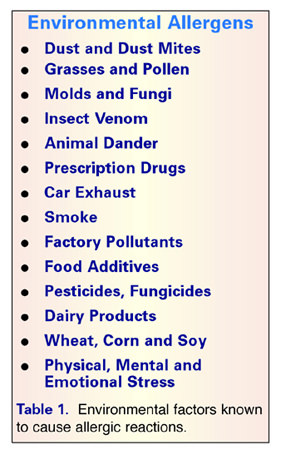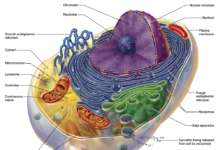Migraine-Reducing Herb Combats Hay Fever and Allergies
By Jim English
Allergic Rhinitis (also called hay fever or allergy) is an allergic condition marked by the inflammation of mucous membranes in the nose (from the Greek word, “rhin,” meaning nose, and “itis,” meaning inflammation). About 41 million Americans suffer from the symptoms of allergic rhinitis. Allergic rhinitis occurs when the body overreacts to a substance – such as pollen – that is otherwise harmless.

Some people inherit their allergies from their parents, while others develop an allergic sensitivity to specific foods or chemicals following repeated exposure (Table 1). In either case, the body recognizes a substance as foreign, or ‘not self’ and produces antibodies to protect the body. Once the body has manufactured antibodies for a specific allergen the stage is set for future allergic reactions. The next time an allergen is detected by an antibody the immune system goes into high gear, triggering the rapid release of histamine and other inflammatory chemicals from specialized immune cells – known as mast cells – that are located in tissues.
As histamine is released into these tissues the result is a localized reaction which can cause a range of allergic symptoms, such as itching eyes, nose and throat, watery eyes, sneezing, stuffy or runny nose, nausea, headaches, and an impaired sense of smell and hearing.
In addition to attacking the sinuses and eyes, histamine can also affect the throat, lungs, stomach, bladder, vagina, muscles, joints, and central nervous system. Histamine also affects brain tissues, causing sufferers to feel “foggy,” confused and unable to concentrate. Left untreated, allergies may lead to chronic swelling of the sinuses and increased risk of infection.
Types of Allergic Rhinitis
There are two primary forms of allergic rhinitis – seasonal and perennial. Allergic rhinitis triggered by the seasonal release of tree, grass or weed pollens is called seasonal allergic rhinitis. Symptoms are most severe during the spring and summer months, when pollen levels are high, and decrease with the arrival of cold weather.
Hay fever triggered by indoor irritants such as feathers, mold, animal dander (hair and skin shed by pets) or dust mites is called perennial allergic rhinitis. This type of allergic reaction can result in year-round symptoms. Because different types of pollen, dust and mold spores exist in various geographic locations, some people may suddenly develop allergic rhinitis after moving.
Treating Rhinitis
The best treatment for allergic rhinitis is to completely avoid the allergenic substances that trigger the reaction. Since this is not always possible, many allergy sufferers turn to prescription and over the counter medications for relief. Over-the-counter medicines line the shelves of pharmacies, calling out to unfortunate victims of these seasonal or chronic problems. While antihistamines and other drugs may help some patients, they also cause serious problems for others. Typical antihistamines may make even the simplest of tasks, such as driving an automobile or operating heavy machinery, difficult, or even dangerous.
Antihistamines
Antihistamines block the effects of histamine after it has been released. Unfortunately, many antihistamines produce side effects, such as dry mouth, nausea, and drowsiness. Other side effects include dizziness, blurred vision, insomnia, and tremors.
Decongestants
Decongestants are often used for short-term relief from nasal stuffiness. Ironically, many decongestants can cause a “rebound” effect that actually promotes the release of histamine release, leading users to ultimately feel even more congested than before.
Corticosteroids
Corticosteroids can reduce allergic reaction by preventing body cells from responding to histamine. These compounds are administered via a nasal spray. For profound allergy symptoms, a one-time, very short course of systemic cortisteroid may be a last resort treatment.
Immunotherapy
Allergy shots may be effective against specific, identifiable allergens, such as ragweed and pollen. Immuno-therapy may take six months before any benefit is noted.
Butterbur: Natural Relief from Hay Fever
Butterbur (Petasites hybridus) is an herb that grows throughout Europe, Asia and North America in low-lying wet areas and marshes. Some say the plant got its name because its large leaves were used to wrap butter during hot weather. For centuries the leaves and rhizomes of this perennial shrub have been used as an important medicinal herb. Recently we reported that modern research has shown that extracts of butterbur contain active ingredients that prevent migraine attacks and reduce the severity and duration of attacks when they do occur. Butterbur is also used in Europe to treat asthma and chronic coughs, prevent gastric ulcers and to treat patients with irritable bladders and urinary tract spasms. Now, new research shows that this unique herb may be as effective as conventional drugs for relieving hay fever and allergies, but without the unpleasant side effects associated with those pharmaceutical agents.
Active Constituents
The main active ingredients of Petasites hybridus are two sesquiterpenes, petasin and isopetasin. Research has shown that petasin possessed anti-spasmodic properties that help to reduce spasms in smooth muscle and vascular walls. Petasin has also been found to be a powerful anti-inflammatory agent that inhibits synthesis of leukotrienes that act as potent pro-inflammatory agents in blood vessel walls and cause bronchoconstriction in asthma. The second active ingredient, isopetasin, has also been found to reduce inflammation by modulating prostaglandin metabolism. Together, these ingredients have an antispasmodic effect on vascular walls, with a marked affinity for cerebral blood vessels.
British Medical Study
A recent study published in the British Medical Journal compared butterbur to the antihistamine drug, Zyrtec® (cetirizine) in patients with seasonal allergies. One hundred and twenty five patients in Switzerland and Germany participated, with 61 using butterbur and 64 taking cetirizine. After two weeks of treatment, the results showed that butterbur treated the symptoms every bit as well as the drug, and that the butterbur patients were just as healthy – emotionally and physically – as the other patients. In addition, even though the drug cetirizine is not supposed to cause drowsiness, it has been reported to do so in 11 to 15 percent of those who take it. Those in the butterbur group reported no drowsiness. The authors concluded that butterbur is as effective a treatment for hay fever as the drug.
Conclusion
While conventional drugs are effective for many hay fever and allergy victims, butterbur offers an opportunity to avoid the unpleasant side effects of those drugs.













